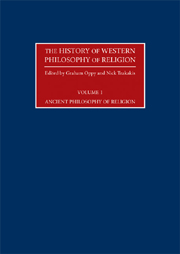Book contents
- Frontmatter
- Contents
- Editorial Introduction
- Contributors
- 1 Ancient Philosophy of Religion: An Introduction
- 2 Pythagoras
- 3 Xenophanes
- 4 Socrates and Plato
- 5 Aristotle
- 6 Epicurus
- 7 The Stoics
- 8 Cicero
- 9 Philo of Alexandria
- 10 The Apostle Paul
- 11 Plutarch of Chaeroneia
- 12 Sextus Empiricus
- 13 Early Christian Philosophers: Justin, Irenaeus, Clement of Alexandria, Tertullian
- 14 Origen
- 15 Plotinus
- 16 Porphyry and Iamblichus
- 17 The Cappadocians: Basil of Caesarea, Gregory of Nazianzus, Gregory of Nyssa
- 18 Augustine
- 19 Proclus
- 20 Pseudo-Dionysius
- Chronology
- Bibliography
- Index
20 - Pseudo-Dionysius
- Frontmatter
- Contents
- Editorial Introduction
- Contributors
- 1 Ancient Philosophy of Religion: An Introduction
- 2 Pythagoras
- 3 Xenophanes
- 4 Socrates and Plato
- 5 Aristotle
- 6 Epicurus
- 7 The Stoics
- 8 Cicero
- 9 Philo of Alexandria
- 10 The Apostle Paul
- 11 Plutarch of Chaeroneia
- 12 Sextus Empiricus
- 13 Early Christian Philosophers: Justin, Irenaeus, Clement of Alexandria, Tertullian
- 14 Origen
- 15 Plotinus
- 16 Porphyry and Iamblichus
- 17 The Cappadocians: Basil of Caesarea, Gregory of Nazianzus, Gregory of Nyssa
- 18 Augustine
- 19 Proclus
- 20 Pseudo-Dionysius
- Chronology
- Bibliography
- Index
Summary
For many centuries the four major works and ten letters that form the Corpus Dionysiacum were thought to be by St Denys the Areopagite, a member of the Athenian Areopagus converted by St Paul (Acts 17:34), just as their author represents them to be. Doubts about the authorship were raised as early as 532 by a Synod in Constantinople after a pro-monophysite group had claimed support for their views in the corpus, and later still by Peter Abelard (1121), Lorenzo Valla (1457) and John Grocyn (1501), but they were first widely published by Erasmus in 1504. Hardly anyone doubted a generally Platonic background to the corpus, although some, like Luther, thought it “pernicious”: Dionysius “Platonizes more than he Christianizes” (1888: 562). The Neoplatonic character of parts of the corpus was definitively demonstrated in 1895 by Hugo Koch and Josef Stiglmayr (independently): Denys' presentation of evil as a parhypostasis, or by-product of reality without genuine existence on its own account, was dependent on Proclus' De malorum subsistentia. In fact, the corpus employs language and quotations from Hellenic authors stretching back through Proclus, Iamblichus and Plotinus to Aristotle, Plato and Parmenides.
- Type
- Chapter
- Information
- The History of Western Philosophy of Religion , pp. 277 - 290Publisher: Acumen PublishingPrint publication year: 2009



